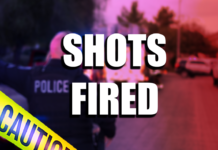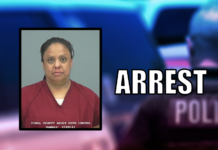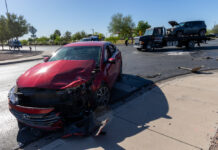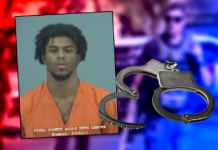
The new body cameras being used by the Maricopa Police Department are meant to protect both officers and civilians.
The use of the footage ensures accuracy to all claims by police and plaintiffs.
“The cameras show exactly what we observed,” Officer Daniel Rauch said. “There is no more debating or falling into ‘he said, she said’ situations. People can see exactly what happened from our point of view, and I think that is the greatest thing that protects the public and protects us as officers.”
Maricopa bought 43 cameras for $97,000. Funds came from an Office of Highway Safety grant and General Government CIP – Police Support Services, Computer Equipment Software, On-Body Cameras & Evidence Storage Projects.
MPD’s program anticipated what is happening nationally. On May 1, the U.S. Department of Justice announced a $20 million Body-Worn Camera (BWC) Pilot Partnership Program.
“This body-worn camera pilot program is a vital part of the Justice Department’s comprehensive efforts to equip law enforcement agencies throughout the country with the tools, support and training they need to tackle the 21st century challenges we face,” U.S. Attorney General Loretta E. Lynch said in a statement. “Body-worn cameras hold tremendous promise for enhancing transparency, promoting accountability and advancing public safety for law enforcement officers and the communities they serve.”
For law enforcement, the cameras allow them to be more confident in their work. If an officer makes an arrest based on something that was discovered after the initial point of contact, they now have footage to demonstrate the initial stop was justified, and every piece of evidence that followed is perfectly warranted to be used in court.
“It’s the closest we can get to true justice,” Rauch said. “By documenting the actual occurrence while it happens, we can go ahead and support ourselves in our decisions. It also documents if there’s any accusations of police overstepping their bounds, we can go and immediately pull the video so it can be viewed and released to (the accuser).”
For the community, the cameras offer a sense of protection. If a member of the community feels their interaction with an officer was unjustified or over the line, they can request to view the footage. In a day and age where “innocent until proven guilty” carries less meaning than proof of innocence, the footage allows all parties to get to the truth.
“The community has been really supportive of the cameras,” Rauch said. It helps us work with the community instead of being seen as over them. It provides backup to both sides.”
The use of the cameras is relatively simple. As long as the cameras are on, they keep the previous 30 seconds constantly recorded. Once officers activate them to record through the battery pack on their chest, the cameras automatically start recording from the previous 30 seconds forward. However, the audio will not be present for the 30 previous seconds before the recording began.
Officers do not have to record their entire shift. As they drive around, the camera remains on, but will not record until activated. Each time the officers begin an action, they activate the camera.
Once their shift is done, officers return to the station and upload their footage. Officers are able to view the footage, but not edit it. Any time an action involving the footage is completed, the action and user are stored in the video’s “history,” which can also be viewed at any time.
The footage is then stored in a secure cloud. How long the footage is stored is dependent on the type of action recorded. For criminal charges, the videos could be stored indefinitely. For misdemeanors and traffic violations, the video may be stored for a month to seven years.
The department is not worried it will run out of any storage space though.
“We contract our storage through TASER,” Rauch said. “Some departments have their own storage, but that is where the high costs come in. You have to constantly buy more space. We won’t have to worry about that in our department.”



![Alleged car thief released without charges Phoenix police stop a stolen vehicle on April 20, 2024. [Facebook]](https://www.inmaricopa.com/wp-content/uploads/2024/04/IMG_5040-218x150.jpg)











